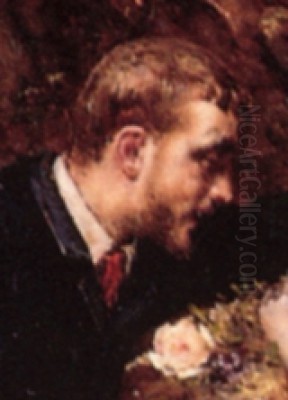
Juan Pablo Salinas y Teruel stands as a significant figure among Spanish painters of the late nineteenth and early twentieth centuries. Born in Madrid in 1871 and passing away in Rome in 1946, Salinas dedicated his artistic career primarily to capturing the vibrant social life and opulent interiors associated with a bygone era, particularly the eighteenth century. His works are celebrated for their meticulous detail, rich colour palettes, and lively depictions of historical genre scenes, earning him considerable acclaim during his lifetime, especially within Italy and across Europe.
Early Life and Artistic Formation in Madrid
Juan Pablo Salinas was born into a creative environment in Madrid, the bustling capital of Spain. His artistic inclinations emerged early, leading him to enroll at the prestigious Real Academia de Bellas Artes de San Fernando. This institution was, and remains, one of Spain's foremost art schools, boasting a legacy connected to masters like Francisco Goya, who had served as its director. Studying at San Fernando provided Salinas with a rigorous academic grounding in drawing, composition, and painting techniques, essential foundations for the detailed style he would later develop.
During his time at the Academy, Salinas would have been exposed to the prevailing artistic currents in Spain. The late nineteenth century saw the continuation of Academic Realism, often infused with historical or regional themes, championed by artists associated with the Madrazo family, such as Federico de Madrazo. Simultaneously, figures like Joaquín Sorolla were beginning to explore the effects of light in a manner influenced by Impressionism, though Salinas's path would diverge significantly from this direction, favouring intricate detail over broad, light-filled brushstrokes. His education instilled a deep appreciation for craftsmanship and historical accuracy.
The Call of Rome: A New Artistic Horizon
In 1886, seeking broader artistic horizons and following a well-trodden path for ambitious European artists, the young Salinas moved to Rome. This move was pivotal in shaping his career and artistic identity. He was not alone; he joined his brother, Augustin Salinas, who was also pursuing a career as a painter. Rome, the Eternal City, was a powerful magnet for artists, offering unparalleled access to classical antiquities, Renaissance and Baroque masterpieces, and a vibrant international artistic community.
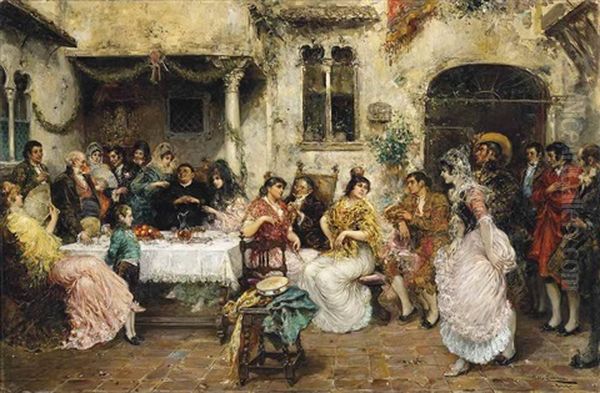
Upon arriving in Rome, Salinas immersed himself in its artistic milieu. He furthered his education by attending classes at the Accademia Chigi and the International Fine Arts Circle (Circolo Artistico Internazionale). These institutions provided opportunities to refine his skills, interact with artists from various nations, and absorb the unique atmosphere of the city. Living and working in Rome placed him at a crossroads of artistic exchange, allowing him to hone his craft amidst the echoes of history and the energy of contemporary practice.
Integration into the Roman Art Scene
Juan Pablo Salinas and his brother Augustin quickly became part of the thriving Spanish artist colony in Rome. This community provided mutual support, shared inspiration, and a connection to their homeland while navigating the international art world. The late nineteenth century saw many Spanish artists drawn to Italy, following in the footsteps of earlier masters. Mariano Fortuny y Marsal, though deceased by the time Salinas arrived, had left an indelible mark on Rome with his dazzlingly detailed Orientalist and Rococo-revival scenes, setting a high bar for technical virtuosity that influenced many, including Salinas.
Salinas spent the majority of his productive years in Rome, establishing his studio there. The city itself, with its historical layers, grand palazzos, and ecclesiastical splendour, provided endless subject matter and inspiration. His decision to remain based in Rome for decades underscores the importance of the city to his artistic development and professional success. He became adept at capturing the spirit of Italian settings, often blending them with nostalgic visions of eighteenth-century life, creating a style that appealed to an international clientele seeking elegance and refinement.
Artistic Style: Detail, Colour, and Historical Evocation
Salinas developed a distinctive artistic style characterized by meticulous attention to detail, a vibrant and rich colour sense, and a preference for complex, populated compositions. His work is often categorized as Academic Realism or historical genre painting, with strong echoes of the Rococo Revival popular during the Belle Époque. He excelled in rendering textures – the shimmer of silk, the plushness of velvet, the glint of metal, and the intricate patterns of fabrics and furnishings. This precision lent an air of authenticity and luxury to his scenes.
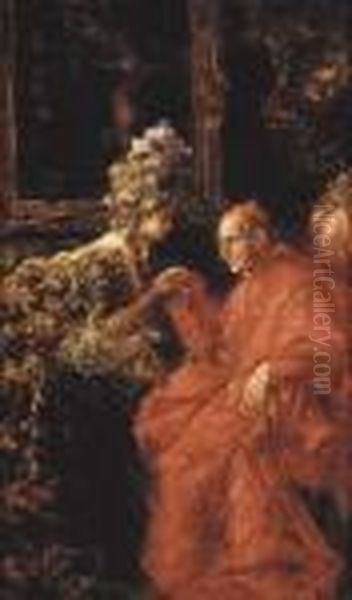
His brushwork, while controlled and precise, was also lively and decorative, contributing to the overall vibrancy of his canvases. Unlike the Impressionists such as Claude Monet or Pierre-Auguste Renoir, who focused on capturing fleeting moments and the effects of light with looser brushwork, Salinas prioritized narrative clarity and detailed description. His approach shares affinities with other European masters of detailed genre painting, like the Frenchman Jean-Louis-Ernest Meissonier, known for his small-scale historical scenes, or even the Dutch-born British painter Lawrence Alma-Tadema, famed for his depictions of classical antiquity, though Salinas focused on a later historical period.
Themes and Subject Matter: Glimpses of the Eighteenth Century
The predominant theme throughout Juan Pablo Salinas's mature work is the evocation of eighteenth-century European aristocratic and bourgeois life. His canvases are often filled with figures dressed in elaborate period costumes, engaged in social activities within sumptuously decorated interiors or picturesque settings. Common subjects include elegant gatherings, musical parties, courtship scenes, festive meals, and encounters within opulent drawing rooms, gardens, or church interiors. He seemed particularly drawn to depicting cardinals and other clergy in moments of leisure or social interaction, often rendered with a light-hearted, anecdotal touch.
While early in his career, influenced perhaps by his academic training or prevailing Romantic sensibilities, Salinas explored literary themes, citing works like Romeo and Juliet or scenes involving Dante and Virgil (as mentioned in some sources), he soon specialized in these historical genre scenes. This focus allowed him to indulge his skill in rendering detail and his fascination with historical costume and decor. His paintings offered his clientele a nostalgic escape into a world perceived as more elegant, graceful, and carefree than the rapidly modernizing era in which they lived. He captured the essence of Spanish and Italian customs, filtered through the lens of eighteenth-century aesthetics.
Notable Works: Capturing Elegance on Canvas
Several works exemplify Juan Pablo Salinas's characteristic style and subject matter. The Marriage (or variations like The Wedding Feast) is frequently cited. These paintings typically depict a bustling, celebratory scene, often set within a grand hall or church interior, showcasing a wedding party in elaborate eighteenth-century attire. Salinas masterfully handles the large number of figures, the architectural details, and the festive atmosphere, paying close attention to individual expressions and interactions amidst the crowd. Such works highlight his ability to manage complex compositions while maintaining a high level of finish.
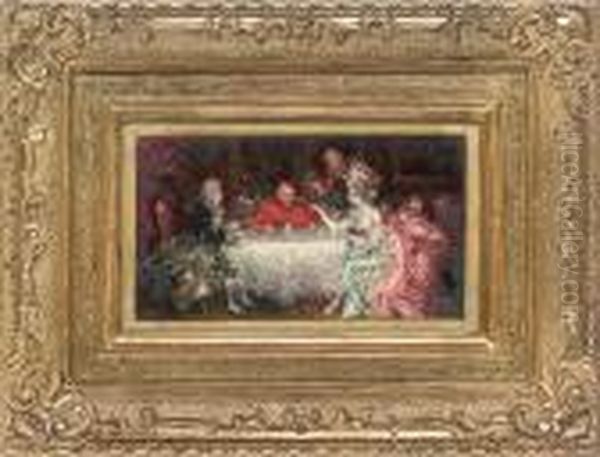
Another recurring theme is captured in titles like The Table, At the Tavern, or A Toast. These scenes often portray smaller groups enjoying food, wine, and conversation, again in period dress and settings. They allow for a focus on still-life elements – glassware, food, tableware – rendered with the same meticulous care as the figures and costumes. La familia de su Eccentricidad, mentioned with specific dimensions (35 x 51 cm) and noted as signed, likely falls within this category of intimate genre scenes, perhaps depicting a specific family or a character study within a domestic setting. Other typical titles found in auction records include Choosing the Necklace, The Cardinal's Visit, and A Musical Afternoon, all reinforcing his focus on moments of leisure, social ritual, and material splendour from the past.
The Salinas Brothers: A Shared Artistic Journey
Juan Pablo Salinas's artistic journey in Rome was closely intertwined with that of his brother, Augustin Salinas y Teruel. They moved to Rome together and were both active painters within the city's art community. While Juan Pablo generally achieved wider recognition, Augustin also specialized in similar historical genre themes, often depicting elegant figures in eighteenth-century settings. They likely shared studio space, models, and inspiration drawn from the Roman environment and its artistic resources.
This fraternal collaboration and shared experience highlight the supportive network that existed within the Spanish artist colony. Working alongside his brother provided companionship and likely a degree of friendly artistic dialogue or rivalry that could spur creativity. While their styles might have had subtle differences, their thematic concerns often overlapped, contributing collectively to the popularity of this particular genre of painting among collectors who appreciated detailed historical evocations.
Context: Navigating the Turn-of-the-Century Art World
Juan Pablo Salinas worked during a period of immense artistic change in Europe. While he adhered to a detailed, academic style rooted in nineteenth-century traditions, the art world around him was being revolutionized by successive avant-garde movements. Impressionism, pioneered by artists like Monet, Renoir, Edgar Degas, and Camille Pissarro, had already challenged academic conventions decades earlier. Following them came the Post-Impressionists – Vincent van Gogh, Paul Gauguin, Georges Seurat, and Paul Cézanne – who pushed artistic expression in radically new directions.
Simultaneously, Symbolism offered dreamlike and mystical alternatives through artists such as Gustave Moreau and Odilon Redon. In Spain itself, while academic painting continued, figures like Joaquín Sorolla achieved international fame with his luminous beach scenes, and Ignacio Zuloaga offered powerful, darker visions of Spanish identity. Ramón Casas depicted modern life in Barcelona. Salinas, however, remained committed to his chosen niche, finding a receptive audience for his meticulously crafted historical scenes. His work represents the persistence of academic taste and technical skill, running parallel to, rather than engaging with, the major modernist experiments of his time. His style found resonance with the detailed historical works of contemporaries like José Villegas Cordero, another prominent Spanish painter active in Rome.
Market Reception and Lasting Legacy
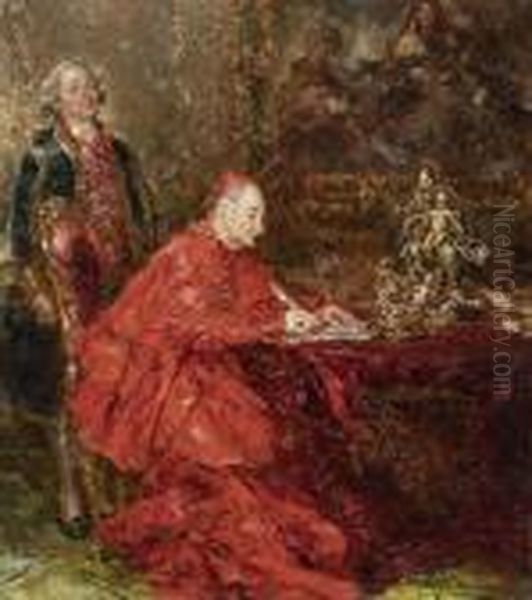
During his lifetime, Juan Pablo Salinas enjoyed considerable commercial success. His paintings, with their appealing subject matter, decorative qualities, and evident craftsmanship, were popular with collectors in Italy, Central Europe, and Russia, as noted in biographical sources. The detailed, jewel-like quality of his work appealed to bourgeois and aristocratic tastes for art that was both narrative and ornamental, evoking a sense of historical luxury and refinement. His works frequently appeared in international exhibitions, further solidifying his reputation.
Even after his death in 1946, Salinas's paintings have continued to find favour on the art market. His works regularly appear at major auction houses, often commanding respectable prices, as indicated by the auction estimates mentioned for works like The Marriage (ranging from £35,000 to £70,000 in different reports, reflecting market fluctuations and specific work quality). This enduring market presence demonstrates the continued appeal of his skillful technique and charming subject matter to a segment of collectors. While perhaps not considered a revolutionary figure in the grand narrative of art history dominated by modernism, Salinas holds a secure place as a highly accomplished practitioner of historical genre painting within the Spanish and broader European academic tradition.
Conclusion: An Enduring Vision of Past Splendour
Juan Pablo Salinas y Teruel carved a distinct niche for himself in the bustling art world spanning the late nineteenth and early twentieth centuries. From his academic training in Madrid under the shadow of Goya to his long and productive career based in Rome alongside his brother Augustin, he remained dedicated to a vision of art centered on meticulous craftsmanship and the evocation of eighteenth-century elegance. His paintings, filled with richly costumed figures, detailed interiors, and lively social interactions, offered his audience a delightful escape into a romanticized past.
Though working during a time of radical artistic innovation led by figures from Monet to Picasso, Salinas successfully cultivated a style that drew upon the legacy of academic realism and the enduring appeal of historical genre scenes, influenced by predecessors like Fortuny. His ability to render textures, capture expressions, and compose complex scenes with clarity and vibrancy secured his reputation and commercial success. Today, his works continue to be appreciated for their technical brilliance and their charming, nostalgic portrayal of European social history, ensuring Juan Pablo Salinas's place as a notable Spanish master of the Belle Époque era.